Entries Tagged as 'Alli'
Whenever I have been observing other cultures, religions, and areas on our tours of London, this one quote from Brick Lane always resounds through my head: “If you mix with all these people, even if they are good people, you have to give up your culture to accept theirs. That’s how it is.” No matter how much some people try to create their lifestyle exactly like how it was from where they come from, it can never be quite exact. I believe that in order for people to adjust and live here in the United Kingdom they have to give up something of themselves because it is just not completely possible to fully live like they used to or want to. The results, I feel, can be both positive and negative.
One of the positives (and negatives) of having these many diverse cultures and religions all found throughout the UK and all trying to adjust, is that it can allow both for ignorance and knowledge. I am sure many people would look the other way when noticing, for example, the splendor of the Shri Swaminarayan Mandir and choose not to learn anything about their lifestyle or religion. They either keep their remarks and thoughts to themselves, or let it out in the form of harsh words and criticisms that do nothing for anybody but make things more complicated. Then there are people, like our group, who (somewhat) chose to visit the Shri Swaminarayan Mandir and tried to keep an open mind when learning about their lifestyle. We may not particularly agree with few or any part of their religion and lives, but I bet every one of us learned something about them. As much as the adjustment of a “new” culture into another can promote ignorance, I feel that it also gives a chance for further knowledge.
In the Shri Swaminarayan Mandir Temple, I noticed their adaptions to living in the UK. One of the major things I noticed that the temple was geared towards educating the public and those of their religion as well. Unlike the Sikh temple, who was not used to giving tours, the Shir Swaminarayan Mandir was clearly adept to giving tours to all those interested and curious. The museum and exhibition (namely called ‘Understanding Hinduism‘) was definitely geared towards those who either had little or no knowledge on their religion. It seemed that the Mandir made a concious choice to allow those curious about their religion to come in and be educated about it. After going through that museum, one could no longer claim they were “ignorant” about that religion.
Even though the Sikh Temple in Southall was a little less “showy” than the Shri Swaminarayan Mandir, I think they also strove to make sure those interested in their lifestyle were educated. Even though they were a little less adept to giving tours to the curious public, they still had pamplets with information on their religion and even welcomed anyone to come and eat with them. Both the Shri Swaminarayan Mandir and the Sikh Temple allowed and welcomed visitors into their places of worship. In addition to giving tours, both religious institutions had libraries for anyone who wanted to browse and learn more. Even though their difference in beliefs and religion might divide them from others, people only have to come and learn more about them. This is partially what makes for these cultures to have trouble adjusting to a new one, for it does not help anyone when one culture refuses to learn about another. People, I feel, don’t want to take the time to find these possible parallels between other time periods, cultures and religions, but they are out there, all they have to do is learn.
Another part of the trouble of some of these religions’ adjustments or even trying to fully create this lifestyle close to home, is generations (mostly the second generations) that want to reject or modify the customs and practices. You see in White Teeth, for example, these conflicts in Magid and Millat, the twin boys of Samad, a man who grew up in Bangladesh. Magid is sent to Bangladesh to be brought up in the proper ways of Islamic teaching. Millat stays here in the UK and grows up and learns in a different manner. The complete opposite happens between the twin boys, for Millat becomes a religious radical and Magid becomes more “English”. These conflicts, whether positive or negative, are necessary for the advancement of a society and a religion. In every century, in every decade, religions and cultures are always being modified, even if it is just slightly. Even though I think that it is sometimes detrimental that these religions have to make some adjustments in order to reside here in the UK, it is the way of life and sometimes can even turn into a positive for their lifestyle.
Tags: Alli · readings
September 7th, 2009 · 2 Comments
During our time in London, we have noticed that many of the religious institutions we have been visiting rely on gift shops and cafés to increase revenue. Some basic internet research shows that many people have mixed feelings about whether or not this practice is acceptable. Generally speaking, we do not believe it is necesarily inappropriate for a church or temple to sell refreshments or gifts related to the location or religion. Given a decrease in European religious sentiment and worldwide economic difficulty, donations aren’t a very reliable source of funding. If a place is to be kept open to a public (tourists and worshipers alike) it needs money to run. Employees and utilities need to be paid and maintenance isn’t cheap. It’s easy to understand the rationale behind the decision to open a shop.
For the most part, the places of worship we have visited had signs informing the guest that the proceeds from the shop or café benefit either local charity or the building itself. For example, St. Martin’s in the Fields’ gift shop benefits “the work” of the church. Additionally, the products sold are related to Christianity, the church itself, and the church’s location. Furthermore, the Shri Swaminarayan Mandir‘s gift shop sold incense, prayer beads, and other products Hindus would need for everyday use in addition to more “touristy” items. We consider all odthese items to be appropraite for such a shop; they are directly related to the place and its purpose.
Whilst visiting the Christ Church College in Oxford (this may or may not have been related to Harry Potter), we stumbled into “The Cathedral Shop” adjacent to the college’s chapel. Most of the items sold by this shop were very similar to the other gifts shops we previously encountered. There were chalices, books, t-shirts, postcards, etc. There was a fairly modest Harry Potter section relating the the films that were partially created at the location alongside a small section dedicated to Lewis Carroll’s Alice in Wonderland, which was written in Oxford.
However, we did notice a few items that did not seem appropriate for a shop entitled “The Cathedral Shop.” Instead, they seemed to be trying VERY hard to appeal to young, hip buyers:

The last time we checked, no religion condones binge drinking and sleeping until 4pm and Oxford isn’t particularly famous for its hangovers.
We’re curious to see what everyone else in the group thinks about the idea of gift shops in religious buildings and what kinds of items they should sell.
Tags: Alli · Churches and Cathedrals · Sarah
Through reading the syllabus beforehand, yesterday and today were two days I was most looking forward to on this trip. Two semesters ago I had taken a class called, What is Hinduism?, at Dickinson and there my love and appreciation for any kind of religion has grown. I was really excited to go to the Sikh temple today because I have some background knowledge on religions in India.
What most interested me in both some parts of Hinduism and Sikhism is their desire to eliminate distractions from your life. I find this task very admirable, being that I am constantly distracted in general and have trouble focusing, even at church. I know with Hinduism that to achieve this goal is called moksha, to be liberated from the cycle of life or samsara through reincarnation (which is generally thought of as a bad thing in Hinduism). To try to explain complicated concepts of Hinduism in two sentences is not easy, so for more information I suggest you look here. Sikhism as well seeks to achieve salvation through disciplined meditation in order to understand God and His messages. I have tried meditation once in my life and I know how difficult it was for me to focus on nothing or on one thing without getting distracted by a fleeting thought. I have such a deep respect for those that can devote their lives to meditation and focusing solely on their religion. At one point our guide was telling us about the five types of distractions that hinder your devotion to God. These distractions are called Maya or “unreality” and are known as greed, lust, ego, attachment and anger. It was interesting to see that parallel to our very similar “seven deadly sins.”
Another part of the day that I enjoyed was how the temple was so simple and uncluttered. After going to both St. Paul’s and Westminster Abbey, where the entire church is filled with statue, memorials, graves, etc it was a nice change to see just plain white walls. Even in the Hindu temple I had been in before, the walls still had big paintings of gods like Krishna. The Sikh temple made it easier to focus on the beauty of their religion, through the lovely songs of devotion drifting in and out of your consciousness and hardly any forms of art to distract you from paying attention and meditating.
What really saddened me in the end was how people can have such a negative impression when they see someone wearing a turban or any sort of South Asian clothing without knowing their background. They probably wouldn’t even know that they maybe are a Sikh, a very welcoming and passive community and religion. Reading in the pamphlet our tour guide gave to us, a quote stuck out to me. A man comments upon the Sikh community as being “very large hearted” and that “in spite of racial differences they co-exist with others happily.” As much as I felt like I stuck out in the temple, I felt a sense of welcome despite my awkward feeling. The fact that they allow anyone to come in and eat, Sikh or non-Sikh, is very nice of them. I would have thought that they wouldn’t want any outside influences, but instead they welcomed it. Even when I went to the Hindu temple before, the people there were so open and willing to teach us about their religion and have us participate. It is days like today that I realize how beautiful religion can sometimes be.
Tags: Alli
August 30th, 2009 · 1 Comment
Today Sarah, Chelsea and I made a journey to the Victoria and Albert Museum. Upon immediately entering the V&A, we noticed that it was going to be a hodgepodge of all sorts of items. The first room we entered featured various nudie sculptures that caught our attention. Then to our right we noticed the “Fashion” exhibit. The “Fashion” exhibit featured everything from a 1700s brocade ball gown to futuristic designs. Being in a girly mood, we decided to go to the jewelry section next, we can dream can’t we?
On the way, we stumbled upon an ironworks exhibit, gargantuan columns, and Asian textiles. One of the best exhibits, we thought, was the Theatre and Performance gallery. This exhibition housed anything from ballet costumes to miniature set designs and various recordings of performances. This kind of exhibit, we felt, was rare compared to the other museums we had visited.
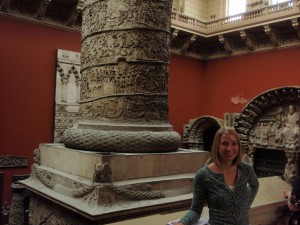
Alli morphed by a gargantuan columnNo caption needed.
As a whole, we felt that this museum showed more socio-cultural exhibits than the rigid British Museum and National Gallery. The 20th Century exhibit showed anything from an iMac to early cell phones. It included a section about technology as an astestic, featuring a pink vacuum cleaner from the 1970s. This museum tended to show more “everyday life” items rather than royal jewels and strictly upper class items that are less easy to relate to. Even the jewelry exhibit included less elaborate pieces, such as funerary rings, that did not necessarily belong to royalty or a famous name. These items weren’t just “dug up from the ground” and put on display, but they were placed in a better context.
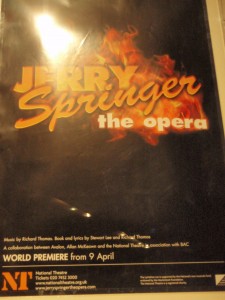
No caption needed.
Additionally, the V&A seemed to be more “British,” containing the most number of galleries dedicated to English artifacts and history. They had 13 rooms entitled “British Galleries: 1760-1900” whereas the British Museum only had 2 rooms and the National Gallery had 4. It is interesting that these two museums are considered “national” museums and yet they have the least amount of national artifacts.
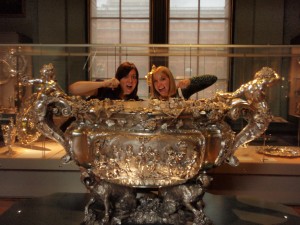
Sarah and Alli drinking from the giant punch bowl
Tags: Alli · Chelsea · Museums · Sarah
While going through the British Museum, the National Gallery and the Tate Modern I noticed the lack of British art and artifacts represented throughout these museums. I learned in my Museum Studies class that even major museums in America there are this lack of American artwork in them. Of course this is mainly because America is such a young country and we are beginning to establish our place in the art world just like other older countries have done. Even so, why is Great Britain still under represented, even within their own country?
I began to observe in every major museum in London that I’ve visited to so far this lack of British art. At the National Gallery there were only a few rooms (about 3) dedicated to the country’s artists. For being the “National Gallery” it seemed to be dominated quite a lot by Italian and French artwork. By viewing the layout of the gallery, it is easy to notice the complete lack of British art. It is also noticeable that it is not even the focal point of the museum, but the rooms displaying the artwork are pushed off to the side.
The British Museum also did not live up to its name. Great Britain only had about 4 parts of the entire “British” Museum showing British artifacts, mostly from the Medieval and Roman time periods. The majority of the museum displayed their stolen “acquisitions” from other parts of the world. And still even in this museum Great Britain was not the focal point in the least, for what is one of the first places you see when you walk in but the stolen Egyptian artifacts.
The Tate Modern also did not display many British artists. The gallery seemed to be dominated by American, French and all other countries other than Great Britain. Even America had a much larger place in this museum because of their prominence and prestige amongst the modern and post-modern art world. If you do a quick browse of this museum’s layout, it is easy to see hardly any British artists.
Why I believe there is a general lack of British art and artifacts is because most museums in a large city are meant to show off the prominence and power of that country. In the British Museum, Britain is still shown as a world power and it proudly displays the “booty” they have collected from their conquests of these other countries. Even in the new modern and post-modern art museum, the Tate, these same ideas still play through, just less pronounced than the other two. Museums are still viewed, even in the 21st century, as places of national pride and places to show off your conquests and the “treasures” to the rest of the world.
Tags: Alli · Museums
August 28th, 2009 · 1 Comment
After experiencing the National Gallery and the British Museum, the Tate Modern was shocking in and of itself. Compared to the beautiful architecture and classical feel of the other two galleries, the vast emptiness and cold steel of the Tate created an almost uncomfortable feeling. Meant to emphasize the artwork displayed, the white walls and dead space made us feel small.
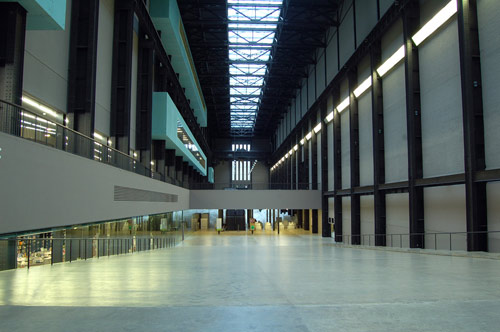
The entrance hall of the Tate Modern
The Tate was also much louder and more family-friendly than the other two museums. Children were sprawled out on the floor and benches, creating their own modern art. Graphic installations were clearly marked by both signs and museum employees. We were impressed by the museum’s effort to be open to all audiences.
Through a combination of choice and naivety, the three of us entered Paul McCarthy’s Projection Room. At first, we were simply disgusted and disturbed by the sexually explicit/grotesque imagery. The videos were so shocking that we can barely even remember what we saw. (For those brave at heart, just google image search “Paul McCarthy” for video examples similar in nature to the exhibit.) A brief peek at the Viennese Actionists exhibit didn’t help to settle our stomachs and minds, so we decided to leave.
Upon returning to the Arran House, we felt obliged to further research McCarthy in attempt to understand the meaning behind his “art.” We discovered he is mocking social rules and standards in addition to the media’s control (read: brainwashing) of our actions. Food and bodily fluid are his medium and his body is used as a paintbrush and a canvas. We found McCarthy views himself as separate from the Viennese Actionists. He states, “Vienna is not Los Angeles. My work came out of kids’ television in Los Angeles. I didn’ t go through Catholicism and World War II as a teenager, I didn’ t live in a European environment. People make references to Viennese art without really questioning the fact that there is a big difference between ketchup and blood. I never thought of my work as shamanistic. My work is more about being a clown than a shaman.”
We’ll leave you with this and let you interpret for yourselves McCarthy’s art and vision.
Tags: Alli · Kelley · Museums · Sarah
August 26th, 2009 · 1 Comment
So I’m beginning to realize that “free days” actually don’t mean that you get to relax any more than on “non-free days”. Yesterday Sarah, Chelsea and I decided to museum it up and we went to both the National Gallery and the British Museum (part 1). Since I am a history major and was considering art school before choosing colleges, I absolutely love observing all the details about paintings and artifacts in museums. History has taught me to look beyond the surface, so I am advising you to do the same because you’ll be surprised by the information you will discover!
I love looking at older paintings because they tell so much about the period and the people in them. For example, I was observing a portrait of a beautiful 18th century woman, and if I did not read further information about the woman, the painting would have lost so much meaning. The woman in the portrait, Manon Balletti, was actually one of the many lovers of the famous Casanova. Around the time this portrait was being painted, Casanova had declared his love for Manon, but she a few months later got married to another. On the surface, this woman looks demure and captivating, but with further research I now view this portrait differently.

Since I love learning about the every-day person and their lifestyle, paintings offer hints into things such as what people ate, what status a person is if a certain object is placed in the picture, how people wore certain types of clothing, etc. Being a historical reenactor as well, observing these paintings are one of the best research methods for a certain period of time. Who would have know that drinking hot chocolate would have been a status symbol in the 1700s? I had known this before, but apparently if a person was painted drinking or pouring a cup of chocolate, it showed that they were wealthy enough to afford such a luxury. Nowadays, we wouldn’t think twice before making ourselves a packet of powedery hot chocolate mix.
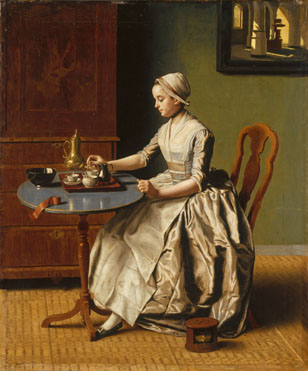
Portrait of a Woman of the Hofer Family, 1470, showed that it is always worthwhile to pay attention to details. If you only walked by and glanced as this painting you would miss the underlying symbolisim behind parts of the painting. In her hands she is holding flowers, symbolicly Forget-Me-Nots, which often signify rememberance. In the left corner of the woman’s headress there is a small fly made to look real. Oftentimes a fly could represent mortality or could just be used to show the artist’s skill of perception. I also noticed that in this painting, and in others from the period, some women wore rings on both of the joints on their fingers (which I think would be awfully uncomfortable!). I have never seen this before in paintings and in this one, if you look at the woman’s pinky finger on her left hand, you can see that she is wearing two rings. Perhaps eventually I will discover why it was fashionable to wear rings like that. It was probably one of those crazy fashion trends of the century.
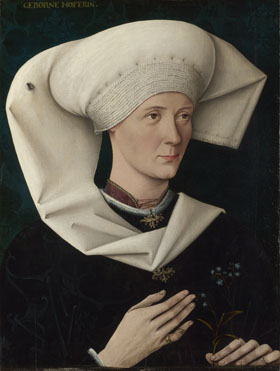
So the next time you rush by an old painting in a gallery or museum, stop and observe it. Ok, so maybe you can’t get past the “funny” headdress the woman is wearing, or the fact that men are wearing bright colored tights, but you can learn so much by looking beyond that. Perhaps you may even discover some parallels to a certain person or time period, such as people for centuries had portraits with their prized pets painted next to them, just like you might have your picture taken wih your favorite pet.
Tags: Alli · Museums

Today I was apart of the group that went to the Dockland Museum and finally got to experience what everyone had been raving about yesterday. Like Azul, I had taken the Museum Studies class last semester and put together an exhibit on co-education this summer, so I can no longer look at museums or exhibits without using a critical eye. Hands down, the London, Sugar, & Slavery exhibit was the best I have ever seen. The task and challenge of the curator to take on a subject that is not particularly easy or pleasant was a feat in itself. And the exhibit was absolutely spectacular.
After reading the lists of ships and passengers at the exhibit’s entrance, I was moved by this satirical painting that followed those disturbing lists. The painting was called May Morning by John Collett, 1765, and showed a crowd of people of different ranks and statuses, all white except for one African man in the center of the painting. At first when I looked at the painting, I though it was interesting that, for the 1700s, the African man was the focal point of the picture and was not standing out in any obnoxious way but just blending in. Then I read the description of the painting and found out that it was meant to be a satire. I also noticed that all of the other people had lighter clothes on and were highlighted, while the African man was in the back and dimmed. I found it interesting that this painting could have been viewed in two completely different lights depending on the knowledge known about it beforehand.
 (sorry it’s blurry, couldn’t use flash).
(sorry it’s blurry, couldn’t use flash).
About halfway through the exhbit I came upon the sight of beautiful china, teacups and saucers and pots. Any other time I would have been delighted at the sight, because I love old teacups and such. But after going through the horrors of the exhibit and seeing the suffering the enslaved Africans had to go through, the sight of these cups full out disgusted me. I knew that people who had no idea of the pain of these people who worked to give them sugar for their tea. I was talking to Audrey, who was viewing the artifacts next to me and she had the same reaction. It is strange how an object that I usually think of as beautiful could be so cruel and disgusting to me.

One of the best points of the exhibit that actually happened in the beginning and resounded in my head while I browsed the exhibit was the words, “This is your history” from the video. I thought it was quite bold, but much needed, of the museum to place those lines simply, but powerfully, at the end of this very moving video. To me, it was like a cold slap in the face, and I believe it was for many other people to, to make them realize that yes this is our history and we have to come to terms with it. Once we accept, learn about it, we can finally move past it, instead of trying to brush this brutal history aside.
This exhibit completely moved me almost to tears. I learned so much from it and was glad to read that a majority of the comment cards were positive about it as well. I hope someday in the near, near future we can all move past pretending the bad parts of our history don’t exist.
Tags: Alli · Museums

Apparently, Sarah and I had not walked enough the past few days and decided to go on an exploration of the Tower Hill section of London yesterday. We arrived at the Tower Hill station, appropriately named, and wanted to walk towards the section labeled “Beheadings”, but decided not to. After walking around the outside of the Tower of London, we decided to head over to the War Monument for the Merchant Navy. It was a beautiful garden/memorial area that had a few people strolling about.

After that, we decided to go whereever the streets led us. We stubbled upon St. Olave’s Church, where Samuel Pepy’s, Mother Goose (apparently) and 365 people from the 1665 plague are burried. Upon more walking, we discovered a church (that I cannot recall the name of) that was left in ruins after the war. There was a quaint garden and small fountain where a few people were sitting around. The ruins were also open to elements and the public and it was interesting to see once stained glass church windows now covered in vines and vegatation. Sarah and I noticed while walking around that there were very few people on the streets once we got away from the more “touristy” areas. I guess it is strange to me that not all of London is bustling along the streets all the time, because it is such a big city, but I am finding that this is not always the case!
Turning a corner, we noticed a sign for Pudding Lane and, thinking that the name was adorable, decided to walk down the lane. Little did we know the significance of this lane! We saw people at the end of it, standing around something and taking pictures. As we walked past a building we were both stunned by a large monument. Appropriately, the monument we stubbled upon is called “The Monument” because it was built to commemorate the start of the Fire of 1666 in Pudding Lane. Now Pudding Lane did not seem so “adorable” anymore. The Monument, I learned, was built by Sir Christopher Wren between 1671 and 1677 and was built to be 61 metres high, the exactly distance between the Monument and the start of the fire in Pudding Lane. Sarah and I, for whatever reason, decided to walk up the 311 steps of the Monument as if we had not walked enough already! The climb though proved itself worth it because we had a marvelous view of London. Then we had to walk back down.

To continue our “stroll” we decided to head towards the “London Bridge” (which is actually called Tower Bridge). After crossing the real London Bridge, we found Southwark Church at the base of it. Southwark Church was a beautiful on the inside, and we managed to step in as a traditional Latin service was going on. We then left the church and headed in the general direction of the Tower (or “London”) Bridge. After about 20 minutes or so of walking, we finally rounded a corner and found ourselves face to face with the Bridge. Even for it being such a commecial site, it is still breathtaking. We noticed there was an exhibit going on in the bridge towers themselves (if anybody would like to do that in their freetime, make note of this!) but we both decided we did not want to do anymore walking up stairs that day!
Even though we did not go into any museums or see many “touristy” sites, Sarah and I still had a fabulous time exploring. Somedays I love going into museums, but I also love just discovering London through randomness and stumbling upon sites that a tourbook would not usually point you towards, those are always the most interesting discoveries to me. So my advice to all of you is to take some free time and go out and just explore! (With another person of course…)
Tags: Alli · Churches and Cathedrals





We arrived at the Camden Town markets around 9:30, after learning that the markets open around 10. In a matter of a half hour, we had found at least 4 different kinds of markets. The first one we explored was the Camden Market, a simple and small market with many snarky T-shirts and punk-rock items. All of us had expected this market to be like the markets you read about in books. Instead of the farmer’s market image with the stands of fresh fruits and vegetables, we were surprised to see many basic retail and punk-rock items. Only a few minutes there were needed. Across the street, was the Inverness Street Market which was smaller and consisted of the produce and tourist stands. However a quick turn put us at the base of the beautiful Camden Lock.
An enchanting bridge provided a pathway into the next part of the Camden market scene. These next three markets: Camden Lock, Interchange and Stable were connected with some indoor, some outdoor, and some both. Camden Lock and Interchange were outdoors and consisted of mostly food stands. Stable, our favorite, was a gigantic, mostly indoor market focusing on vintage clothing and antiques but with different vibes and from different cultures. We were surprised to observe that in the markets there was very little diversity amongst the shoppers. There were mostly white, British, young and middle-age shoppers, hardly any families or other ethnicities. The shops themselves though, were diverse in tastes and products from a Middle Eastern furniture store with beautiful chess sets to Cyberdog, a futuristic-themed clothing and accessory store. At one point there were also 6 restaurants in a row, ranging from Japanese, Indonesian, Mexican, BBQ, Indian, and Italian.
Since the tube stop was packed with people coming off, a quick turn onto a side street revealed a quieter neighborhood with few people about. This could mean that the patrons of these markets are not from Camden town and perhaps that many Londoners are drawn to it as a mecca of the trendy, funky, and diverse.
Having heard so much about Camden Town we were looking forward to spending the day browsing the markets. However, we found that 3 hours was sufficient to get the feel of the area and its visitors.
Tags: Aidan · Alli · Amanda · Markets










 (sorry it’s blurry, couldn’t use flash).
(sorry it’s blurry, couldn’t use flash).







